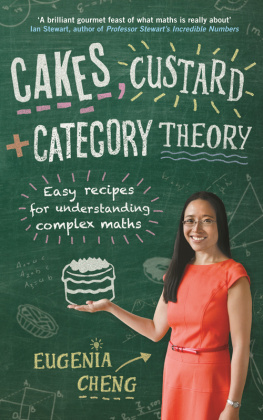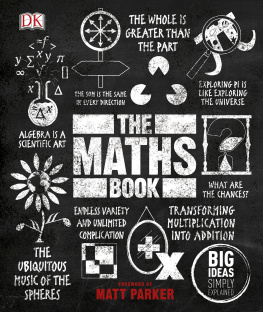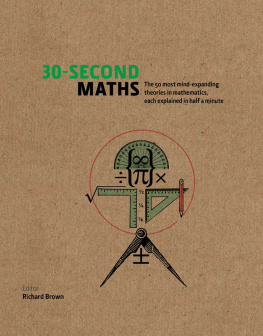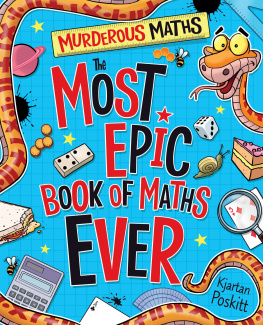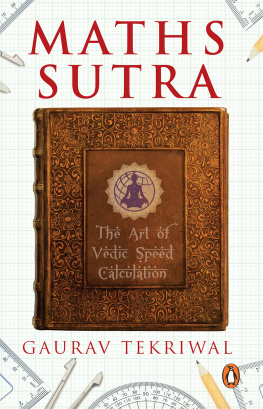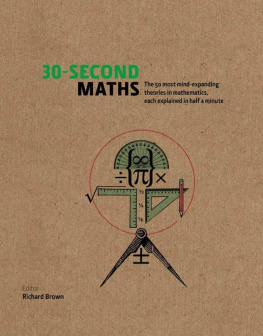CAKES, CUSTARD + CATEGORY THEORY
Eugenia Cheng is Senior Lecturer in Pure Mathematics at the University of Sheffield. She was educated at the University of Cambridge and has done post-doctoral work at the Universities of Cambridge, Chicago and Nice. Since 2007 her YouTube lectures and videos have been viewed over a million times. A concert pianist, she also speaks French, English and Cantonese, and her mission in life is to rid the world of maths phobia.
CAKES, CUSTARD + CATEGORY THEORY
Easy recipes for understanding complex mathematics
EUGENIA CHENG

First published in Great Britain in 2015 by
PROFILE BOOKS LTD
3 Holford Yard
Bevin Way
London
WC1X 9HD
www.profilebooks.com
Copyright Eugenia Cheng, 2015
The moral right of the author has been asserted.
All rights reserved. Without limiting the rights under copyright reserved above, no part of this publication may be reproduced, stored or introduced into a retrieval system, or transmitted, in any form or by any means (electronic, mechanical, photocopying, recording or otherwise), without the prior written permission of both the copyright owner and the publisher of this book.
A CIP catalogue record for this book is available from the British Library.
eISBN 978 1 78283 082 5
To
my parents
and Martin Hyland
In memory of
Christine Pembridge
They say mathematics is a glorious garden. I know I would certainly lose my way in it without your guidance. Thank you for walking us through the most beautiful entrance pathway.
From a students letter to the author
University of Chicago, June 2014
PROLOGUE
Here is a recipe for clotted cream.

Ingredients
Cream
Method
Pour the cream into a rice cooker.
Leave it on warm with the lid slightly open, for about 8 hours.
Cool it in the fridge for about 8 hours.
Scoop the top part off: thats the clotted cream.
What on earth does this have to do with maths?
Maths myths
Maths is all about numbers.
You might think that rice cookers are for cooking rice. This is true, but this same piece of equipment can be used for other things as well: making clotted cream, cooking vegetables, steaming a chicken. Likewise, maths is about numbers, but its about many other things as well.
Maths is all about getting the right answer.
Cooking is about ways of putting ingredients together to make delicious food. Sometimes its more about the method than the ingredients, just as in the recipe for clotted cream, which only has one ingredient the entire recipe is just a method. Maths is about ways of putting ideas together, to make exciting new ideas. And sometimes its more about the method than the ingredients.
Maths is all either right or wrong.
Cooking can go wrong your custard can curdle, your souffl can collapse, your chicken can be undercooked and give everyone food poisoning. But even if it doesnt poison you, some food tastes better than other food. And sometimes when cooking goes wrong you have actually accidentally invented a delicious new recipe. Fallen chocolate souffl is deliciously dark and squidgy. If you forget to melt the chocolate for your cookies, you get chocolate chip cookies. Maths is like this too. At school if you write 10 + 4 = 2 you will be told that is wrong, but actually thats correct in some circumstances, such as telling the time four hours later than 10 oclock is indeed 2 oclock. The world of maths is more weird and wonderful than some people want to tell you
Youre a mathematician? You must be really clever.
Much as I like the idea that I am very clever, this popular myth shows that people think maths is hard. The little-understood truth is that the aim of maths is to make things easier. Herein lies the problem if you need to make things easier it gives the impression that they were hard in the first place. Maths is hard, but it makes hard things easier. In fact, since maths is a hard thing, maths also makes maths easier.
Many people are either afraid of maths, or baffled by it, or both. Or they were completely turned off it by their lessons at school. I understand this I was completely turned off sport by my lessons at school, and have never really recovered. I was so bad at sport at school, my teachers were incredulous that anybody so bad at sport could exist. And yet Im quite fit now, and have even run the New York Marathon. At least I now appreciate physical exercise, but I still have a horror of any kind of team sport.
How can you do research in maths? You cant just discover a new number.
This book is my answer to that question. Its hard to answer it quickly at a cocktail party, without sounding trite, or taking up too much of someones time, or shocking the gathered company. Yes, one way to shock people at a polite party is to talk about maths.
Its true, you cant just discover a new number. So what can we discover thats new in maths? In order to explain what this new maths could possibly be about, I need to clear up some misunderstandings about what maths is in the first place. Indeed, not only is maths not just about numbers, but the branch of maths Im going to describe is actually not about numbers at all. Its called category theory and it can be thought of as the mathematics of mathematics. Its about relationships, contexts, processes, principles, structures, cakes, custard.
Yes, even custard. Because mathematics is about drawing analogies, and Im going to be drawing analogies with all sorts of things to explain how maths works. Including custard, cake, pie, pastry, doughnuts, bagels, mayonnaise, yoghurt, lasagne, sushi.
Whatever you think maths is let go of it now.
This is going to be different.
part one
MATHEMATICS
WHAT IS MATHS?

Gluten-free chocolate brownies
Ingredients
115 g butter
125 g dark chocolate
150 g caster sugar
80 g potato flour
2 medium eggs
Method
Melt the butter and chocolate, stir together and allow to cool a little.
Whisk the eggs and the sugar together until fluffy.
Beat the chocolate into the egg mixture slowly.
Fold in the potato flour.
Bake in very small individual cases at 180C for about 10 minutes, or until theyre as cooked as you want them.
M aths, like recipes, has both ingredients and method. And just as a recipe would be a bit useless if it omitted the method, we cant understand what maths is unless we talk about the way it is done, not just the things it studies. Incidentally the method in the above recipe is quite important these dont cook very well in a large tray. In maths the method is perhaps even more important than the ingredients. Maths probably isnt whatever you studied at school in lessons called maths. Yet somehow I always knew that maths was more than what we did at school. So what is maths?
Recipe books
What if we organised recipes by equipment?
Cooking often proceeds a bit like this: you decide what you want to cook, you buy the ingredients, and then you cook it. Sometimes it might work the other way round: you go wandering around the shops, or maybe a market. You see what ingredients look good, and you feel inspired by them to conjure up your meal. Perhaps theres some particularly fresh fish, or a type of mushroom youve never seen before, and you go home and look up what to do with it afterwards.
Next page
